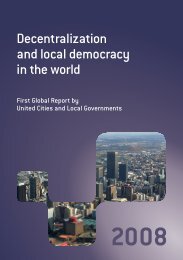Making Cities Resilient Report 2012
Making Cities Resilient Report 2012
Making Cities Resilient Report 2012
You also want an ePaper? Increase the reach of your titles
YUMPU automatically turns print PDFs into web optimized ePapers that Google loves.
CHAPTER 4 | What are local governments doing to build resilience<br />
city council regarding risk tolerance and risk reduction priorities (1, 41). Albay Province has a communitybased<br />
early warning system and community-based communication protocols and evacuation procedures.<br />
In Bhubaneswar, the municipality has trained residents as volunteers in search and rescue, first aid, relief<br />
management, water and sanitation, damage assessment, debris management (14, 9).<br />
Some municipalities are trying to share the burden of risk reduction by encouraging households to do their<br />
part. For example, to reduce the burden on the municipality of flood preparedness, communities in Moshi<br />
are encouraged to clear drains in front of their houses each week. Households are also encouraged to<br />
store food and crops for use during drought periods (40). San Francisco, Cebu has demonstrated innovative<br />
ways of engaging the public and decentralising governance to deal disaster risk, social vulnerability and<br />
environmental sustainability in a mutually reinforcing way (see Box 3.1).<br />
Box 4.4 : Building resilience in San Francisco, USA<br />
San Francisco, California (USA) is exposed to high seismic risk as well as potential risk from tsunamis,<br />
drought, landslides and flooding. The city is recognised as a leader in sustainability, having been named<br />
the greenest city in North America by Siemens Green City Index in 2011. It has also made great progress<br />
in building its resilience. The strength of the city’s resilience is largely the product of its comprehensive<br />
institutionalization of disaster risk reduction and the participation of a wide range of actors in its various<br />
programmes, committees and activities. The City and County of San Francisco (CCSF) assigns a budget<br />
for disaster risk reduction that includes staff and projects. Funding is provided for free disaster response<br />
training for interested citizens; free assistance for business continuity planning is offered to non-profit<br />
organisations to help improve preparedness of low-capacity stakeholders.<br />
The agency with overall responsibility for disaster preparedness, mitigation and response is the Department<br />
of Emergency Management (DEM), whose many responsibilities include resource and financial allocation,<br />
public awareness, city-wide hazard plans, coordinating training for city departments and external<br />
agencies/partners, and activating the Emergency Operations Centre (EOC) in emergencies. It also runs a<br />
large number of subsidiary programmes, including:<br />
• Disaster Preparedness Coordinators: CCSF requires each department to have a coordinator; all meet<br />
regularly to share information and develop action plans.<br />
• Disaster Council: Chaired by the Mayor, the Disaster Council is composed of CCSF department heads,<br />
city officials and private sector representatives; meets quarterly to share information and ensure<br />
stakeholder participation in emergency planning.<br />
• Lifelines Council: A public-private partnership with major utility companies to improve infrastructural<br />
strength and reliability in case of a hazard event by understanding mutual roles and capacities and<br />
plan according to these.<br />
• Ten Year Capital Plan: Annually, the CCSF adopts a ten-year capital expenditure schedule for publicly<br />
owned services and infrastructure. The plan is intended to connect all city stakeholders from a<br />
unified perspective, and makes recommendations to the Mayor.<br />
One of the most innovative programmes initiated by the DEM is the Neighbourhood Empowerment Network<br />
(NEN). The goal of the NEN is twofold: to source information from the public about their needs and priorities<br />
so that disaster risk reduction activities are appropriately attuned to these, and to empower residents<br />
<strong>Making</strong> <strong>Cities</strong> <strong>Resilient</strong> <strong>Report</strong> <strong>2012</strong> | 45

















